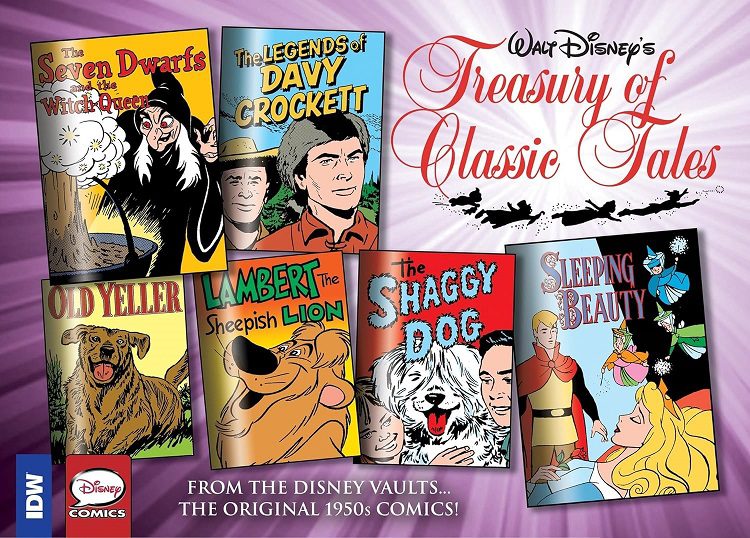
While Disney had previously run newspaper comic strips before it, their Treasury of Classic Tales was a Sunday strip that featured 129 stories, running from July 13, 1952 until February 15, 1987. The Library of American Comics is republishing them and the 13 stories in Volume Two, which are collected in a book for the first time, include adaptations of films, both animated and live-action, and original stories. Animation historian Michael Barrier provides Introductions for the book and for each strip. Written by Frank A. Reilly and drawn by Jesse March, except where noted, they are:
- The Legends of Davy Crockett (July 17, 1955-January 8, 1956)
- The Littlest Outlaw (January 15, 1956-March 25, 1956)
- The Great Locomotive Chase (April 1, 1956-July 29, 1956)
- Lambert the Sheepish Lion (August 5, 1956-September 30, 1956) – drawn by Floyd Gottfredson
- Westward Ho the Wagons! (October 7, 1956-January 27, 1957)
- Gus and Jaq (February 3, 1957-March 31, 1957) – drawn by Ken Hultgren
- Johnny Tremain (April 7, 1957-June 30, 1957)
- Perri (July 7, 1957-November 24, 1957)
- Old Yeller (December 1, 1957-February 23, 1958)
- The Seven Dwarfs and The Witch-Queen (March 2, 1958-April 27, 1958) – written by Floyd Gottfredson; drawn by Julius Svendsen
- The Light in the Forest (May 4, 1958-July 27, 1958)
- Sleeping Beauty (August 3, 1958-December 28, 1958) – written by Floyd Gottfredson; drawn by Julius Svendsen
- The Shaggy Dog (January 4, 1959-April 26, 1959)
Fess Parker’s portrayal of Davy Crockett for Walt Disney was a rousing success. The first three of the five TV episodes that aired on the 1954-55 season of Disneyland were edited together into the movie Davy Crockett, King of the Wild Frontier. After its release in May and before the final two episodes aired the following autumn, Crockett and his sidekick George Russell appeared is this original “legend” that found them helping Thirza Todd, who recently lost her husband and home to Comanches, whose Chief wants to marry Todd, but no reason is given to explain the reason why.
Next up are two adaptations from live-action films, The Littlest Outlaw, about a young boy who steals a horse from its cruel trainer in Mexico, and The Great Locomotive Chase, based on a Civil War-era story that Buster Keaton fans will recognize as the inspiration of The General. Barrier comments that both strips “dispensed with the [film’s] opening,” but as someone who hasn’t seen either, both stories were easy to jump into.
Lambert the Sheepish Lion tells a familiar story about a baby animal left with the wrong parent who eventually saves the day when he embraces his true nature. Revealing a streak of insensitivity and a lack of originality by Reily, Westward Ho the Wagons! presents another tale where Native Americans want a white female for their tribe. It’s unfortunate he couldn’t find a heroic role for them or presented their side of the story.
Tied in with the theatrical re-release of Cinderella, mice Gus and Jaq star in their own tale about them and their friends helping Cinderella find her brooch. Johnny Tremain takes readers to pre-Revolutionary War Boston for a tea party and the beginning of Paul Revere’s ride. Perri is a fun forest adventure starring a female squirrel of the same name from a Disney “True-Life Fantasy” also of the same name. The story was written by Felix Salten, who wrote Bambi, and it turns out shared universes aren’t a new phenomenon.
The classic Old Yeller has an alternate ending that lessens the dramatic impact. The Seven Dwarfs and the Witch Queen is an original story with a terrible resolution as she inexplicably has an “all-purpose spell remover” lying around her lab. Also set before the Revolutionary War, The Light in the Forest is about the uneasy truce between the Delaware Indian Nation and white settlers. After a treaty was signed and prisoners were returned, particularly True Son, a white boy raised by the Delaware chief, the tensions didn’t ease. This story provides a better balance between the sides. The book concludes with two Disney classics, Sleeping Beauty and The Shaggy Dog.
For fans of Disney and comic strips, this latest volume of Disney’s Treasury of Classic Tales is as wonderful as the first. The stories are well paced in these abbreviated versions. The artwork is the real stand out. Jesse March handled the live-action material and does very good work creating the different settings and evoking action. The others who handled the animated works capture the studio’s house style, creating the sense that one is seeing the films in the panels before them. I, for one, am very glad Disney has opened the vaults and allowed IDW to present these strips to a new audience.